Okra plants are easy to grow and perfect for beginners. It is a warm-season vegetable that will bloom first. Its scientific name is Abelmoschus esculentus. Okra is also called Bhendi. It is a hot season vegetable rich in Vitamin A and can be eaten in many ways. Let’s check out the top 15 ways to boost okra crop yield below.
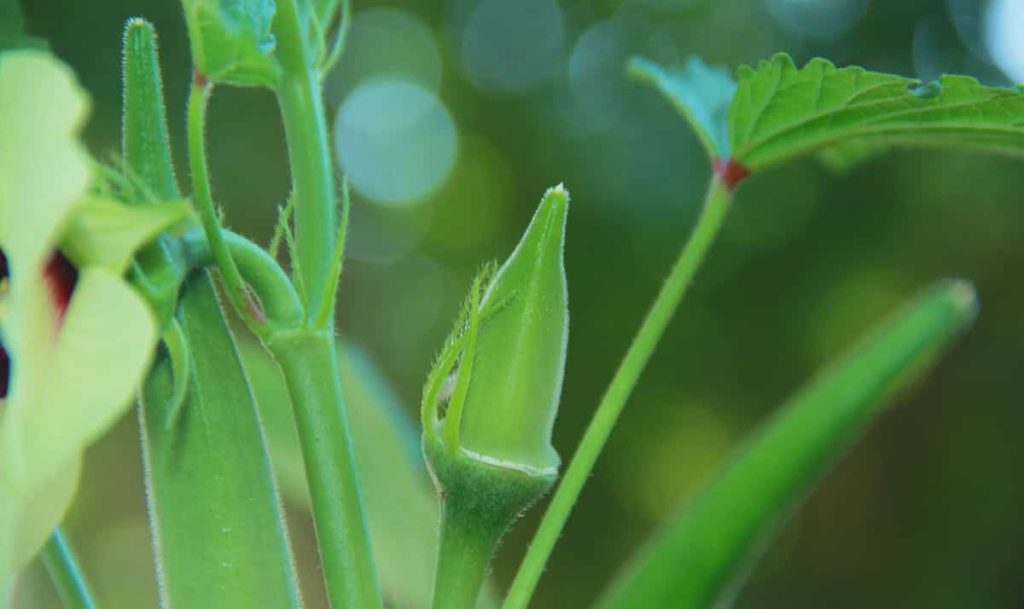
Top 15 ways to boost Okra crop yield
Step 1: Select high-yield varieties
Kashi Kranti, Kashi Pragati, Arka Anamika, and Parbhani Kranti are high-yielding varieties. Kashi Kranti variety has proved its dominance over other varieties in terms of both characteristics (production and growth), while in agricultural methods, it is best and best for the Okra crop. Some varieties of Okra have higher yield potential than others.
For example, a dwarf Okra variety will probably not produce a large variety, and Okra in a pot will not produce as many pods as oats in the ground. Most full-size Okra varieties will yield a lot of Okra. Still, the two most recommended varieties of Okra for both reliable and high yields are Clemson Spineless Okra and Heavy Hitter Okra. Some other high yield Okra varieties are;
- OH-152: Tall plant frame with good strength. Green shiny, thin, easy to pick, first market pod in 42-45 days of sowing.
- OH-597 Plant: Dwarf to medium-sized, shrubby plant with 2-3 lateral branches. Pods: Dark green, shiny, thin, easy to pick, first market pod in 42-45 days of sowing.
- OH-2324: Medium tall, strong, deeply cut leaves. Pods: Green, smooth, uniform, tender, 10-12 cm in length. Day of the first harvest: 46 days after sowing. Disease: Good field tolerance for YVMV.
- OH-102 Plant: A medium-sized plant with good strength and deeply cut leaves. Dark green, smooth, uniform, and soft pods. Good re-flushing and easy picking. Disease: Good field tolerance for YVMV.
Step 2: Climate requirements for optimum plant growth and yield
Okra is a heat-loving plant that cannot withstand low temperatures for long and can be very dangerous to cold plants. Irrigation arrangements should be made where there is drought. Okra is hard and performs well in many types of soil. It grows well even where the soil is poor. So, this is something to try in areas of your garden where you have not been able to grow anything.
Okra is suitable for many soils, but the ideal soil for its cultivation is sandy loam which has good drainage and organic matter. It can grow in heavy soils if proper drainage is available. Okra plants do not like to get wet. Okra needs a little acidity for neutral soil. You can test the soil for pH. A pH level of 5 – 6.5 is best for Okra. To a depth of 8 – 10 inches. Make a fertile bed with free drainage soil with lots of organic matter, including fertilizer. As the Okra plants mature, add organic fertilizer with nitrogen to help the plant continue to produce pods.
Step 3: Land preparation for getting more yield
Okra is sown on ridges or flat soil. If the soil is heavy, then sowing should be done on slopes. Using organic fertilizers such as neem cake and poultry manures will improve plant growth and yield in this crop. Okra is usually grown in places where the crop gets sunlight throughout the day. Soil types may vary for Okra production, looms and sandy looms are preferred, but heavy soils can also produce well if water accumulation in the soil is avoided.
If soil drainage is minimal, Okra will benefit from the use of freely raised earthen beds. The Okra plant will tolerate poor soil as long as the soil is well-drained. It is good to mix a little soil and local soil. Soil increases density and will help retain moisture and retain more water than sandy soil.
In case you missed it: Fertilizer Management for Okra: Dose, NPK, and Schedule
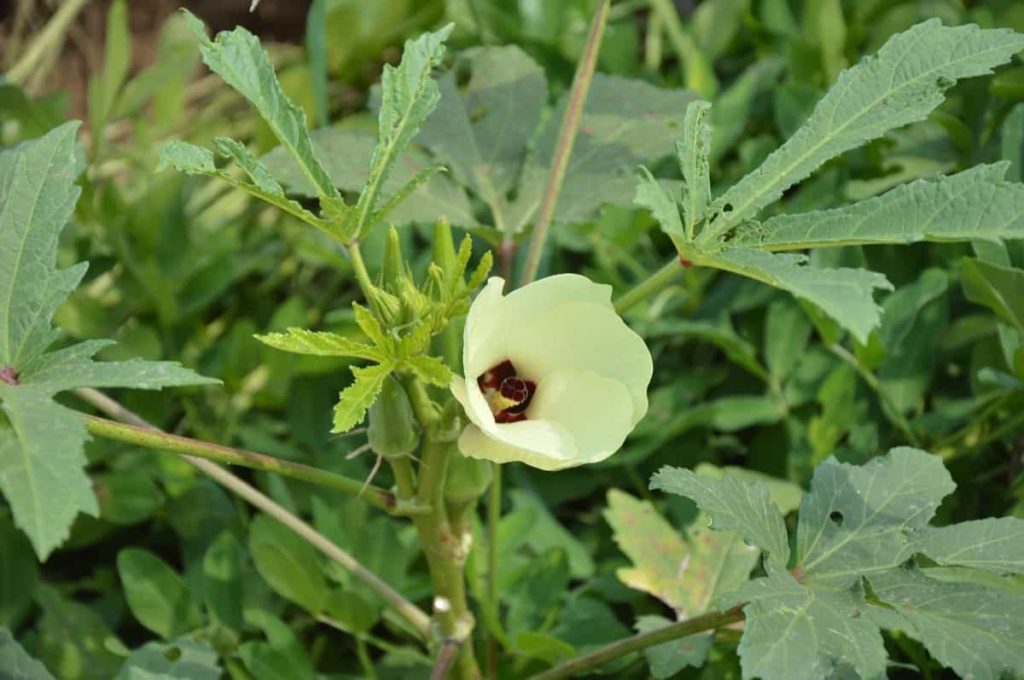
Step 4: Start your Okra seeds to maximize plant size and yield
If you live in a location with hot summers and mild winters, it is easier to plant Okra in your garden than start it indoors. When the plants are strong, and the weather is warm, you will transplant them into your garden. To start the seed inside, place the seeds in the stomach seed starter and place them well in the water.
Step 5: Spacing to maximize plant size and yield
Okra planted too close together, or container sprouts should be placed in a pot that is too small to produce as many pods and may produce smaller pods. Adequate spacing requirements for Okra ground row are between 12 and 24 inches (usually 18 inches is recommended). To produce container-grown Okra, apply at least 5 gallons of container to maximize plant size and yield. It also means keeping your pot clean.
Remove weeds around your Okra plants, especially when they are young. In the summer, ripe Okra will grow many herbs, but you should still weed your oatmeal patch to ensure no competition for nutrients and water.
Step 6: Feeding management to increase pod production
Although Okra grows easily in the beginning, it helps to enrich the soil to help it grow in all seasons. It helps start with standard soil; however, spray organic fertilizer 4-6 weeks after planting for maximum growth. If you do not have livestock, you can buy well-stocked, rotted, old manure from horses, chickens, cows, etc. The use of organic fertilizers will help increase pod production.
Composted around the plant in the middle of the season will help it to keep growing. Especially in the middle of the season, when Okra plants are 18 – 24 inches tall, they will benefit from nitrogen-rich organic fertilizers. Okra requires a lot of energy to make seed pods. Feeding extra nutrients will help ensure optimal growth and will help produce Okra in all seasons.
Applying more fertilizer will harm the production of Okra more than less fertilizer. Too much nitrogen can promote leaf growth rather than pod production, but if you have too much sandy soil that does not retain nutrients well, continuing to use high nitrogen fertilizers later in the season can be necessary for continued pod production.
Step 7: Water requirement for more plant growth
The Okra should be watered at least one inch a week. Water every morning to moisten the soil well, except for heavy rains. Okra can withstand a little drought but is much better when given plenty of water in summer. It is best to water the Okra in the morning, so the plant has time to dry before nightfall. If water stays in the garden bed overnight, it can cause plants to rot. When you water the pot, try not to water the leaves.
In case you missed it: Growing Okra in Australia: At Home, Planting Season, and Guide
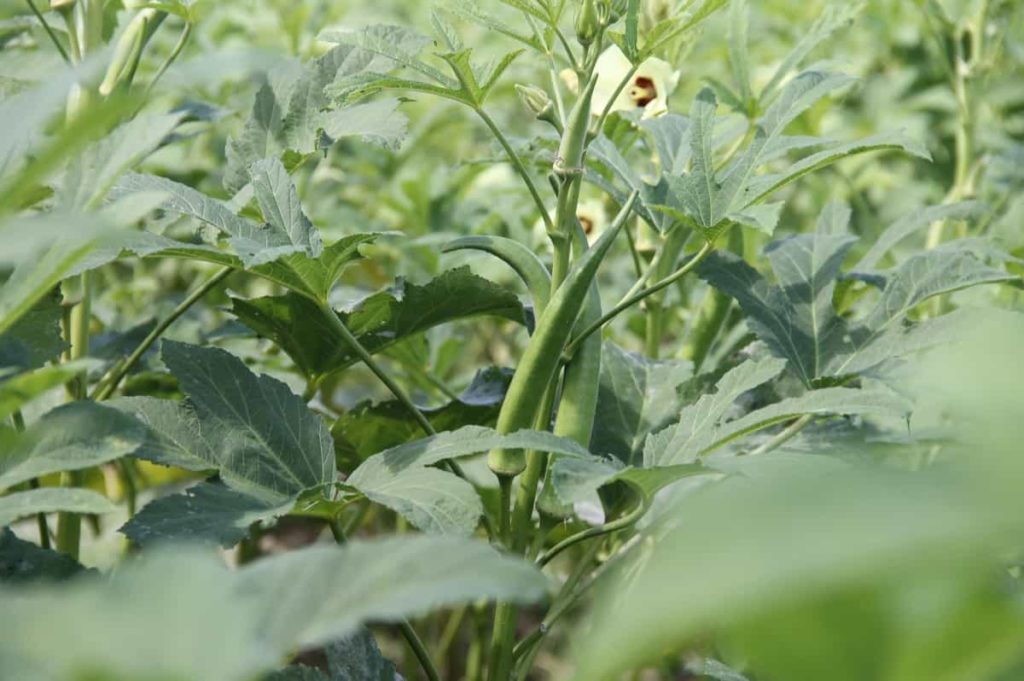
Okra requires regular, even water for continuous production. Okra is known for its drought tolerance, but drought can adversely affect pod production. At the same time, avoid placing your pot in wet soil, which can cause roots to rot. Okra plants are especially vulnerable to root rot in cold, wet soils. Suppose you live in a place with constant, heavy rain; plant Okra on the hills to allow more drainage.
For container-grown Okra, ensure that the potting soil is well-drained and that the pots have proper drainage holes. Okra is grown in the rainy season without irrigation in areas with high rainfall where rainfall distribution is evenly distributed during the growing season. Light irrigation is given immediately after sowing to ensure good germination. In summer, the crop is irrigated at 4-5 days intervals. Moisture pressure during fruit sets reduces fruit quality and yield.
Step 8: Why aren’t Okra plants growing?
Non-blooming Okra can cause by a lack of water. Okra is more drought tolerant than many garden plants, but watering it will keep it healthy and make it more productive. In addition, Okra prefers fertilizers that contain more phosphorus than nitrogen. You may have planted Okra seeds too early or gotten too wet and not sprouted. If you already have some progress, it may be that they are not getting enough sun.
Step 9: Seed rate and seed treatment for more production
Seed rate – Okra needs space to grow well. A seed rate of 4-6 kg per acre is used for rainy season crops (June to July) with 60×30 cm spacing for branched varieties and 45×30 for non-branched varieties. The seed rate is 15-18 kg per acre till mid-February and 4-6 kg per acre for sowing in March.
Seed treatment – Seed germination can be increased by soaking the seeds in water for 24 hours. Seed treatment with Carbendazim will protect the seeds from soil fungus infestation. Soak the seeds in Carbendazim solution 2 grams per liter of water for 6 hours and dry in the shade. Then finish sowing immediately. For better germination and to protect the crop from soil-borne diseases, treat with Imidacloprid by 5 ml per 1 kg seed and then treat with Trichoderma viride by 4 g / kg seed.
In case you missed it: Guide to Growing Okra/Bhendi in Texas: For Beginners, Soil Preparation to Harvest
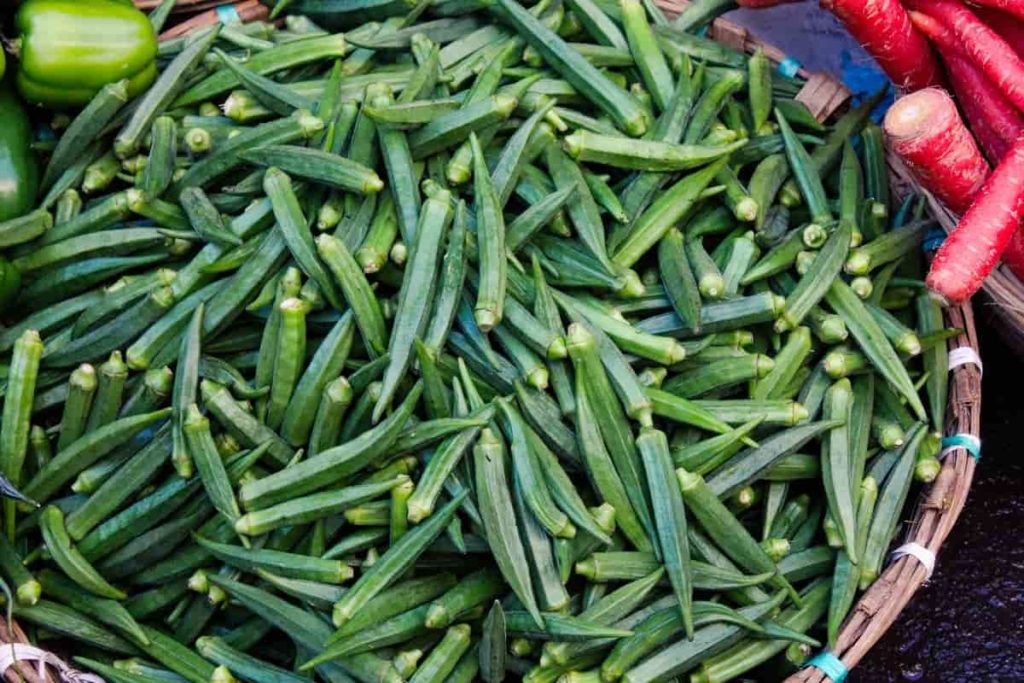
Step 10: Okra flower drop causes and control
If your plant is dropping its flowers and no pods are forming, it is probably due to environmental issues. Okra needs full sun to grow well. Okra blossom drop can occur if you are particularly dreary or exposed to rain. Temperature fluctuations can pressure a plant and cause it to lose flowers.
Step 11: Pests and disease control for getting more plant yield
Okra is not particularly susceptible to pests or diseases, but both are always possible. With crop rotation, high-quality seeds, adequate air circulation, and adequate humidity avoid the need for later troubleshooting. Keep your veg patches clean, and remove dead leaves and old plants. Look for cabbage worms, and flea beetle leaves chewing, and check for bug eggs and whiteflies on the underside of the leaves.
Picking insects by hand or dipping them in a continuous stream of tap water is usually necessary to prevent infection. Sometimes it is required to control the insects that attack the Okra. Check your crop regularly, especially at the beginning of the season. It is the time when aphids usually appear. Later, plants and pods may be attacked by green stink bugs, cabbage loopers, corn ear bugs, European corn borers, and leafy plant bugs.
Stinkbugs, aphids, and corn earworms all like to feed on Okra plants. Plants are hardy and usually do not fail due to pests, but keeping their populations small is a good idea to get the most out of your Okra crop. Regularly inspect stems and leaves for holes, yellow leaves, and other signs of insect infestation. You can pick insects by hand or spray the leaves with soapy water to keep them away.
Crop rotation helps control diseases in the Okra plant. Okra is susceptible to wilting, root-knotted nematodes, and southern stem blight. Check regularly for infections and seek appropriate treatment.
Okra can be attacked by fleas, caterpillars, and other beets. Spraying plants with Spinosad is a formally approved method of controlling these pests. Corn earworms are found on Okra plants. They can be controlled organically using a spray or dust containing the biological pesticide Bacillus thuringiensis.
Step 12: Fertilizer requirement for proper Okra growth
Reapply fertilizer as a side dressing – When the plants are 6 to 8 inches tall, reapply the side-dress plants with the fertilizer after two to three weeks. Side dressing is a method to provide the required fertilizer during very strong plant development. Dig a shallow trench about six inches from the base of the plant and apply granular compost at the bottom of the trench, following the package instructions for the appropriate amount. Cover the manure with soil.
In case you missed it: Red Okra vs Green Okra: Which Makes You Rich?
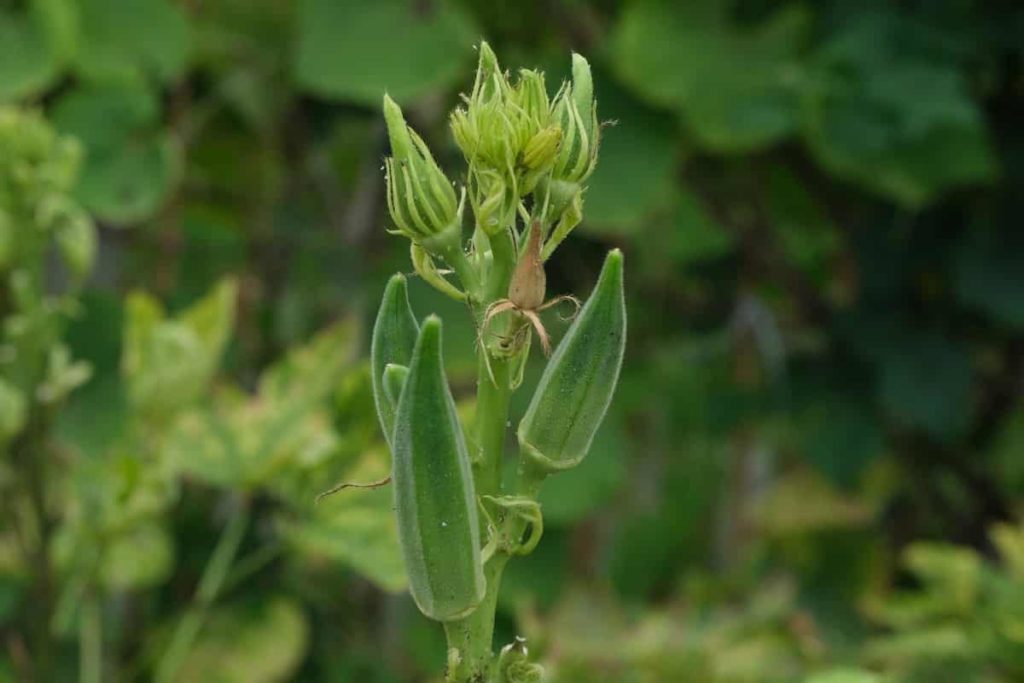
Irrigate and Reapply fertilizer – Reapply fertilizer every four to six weeks during the growing season (probably most often when growing Okra in a container). Irrigate the soil each time you apply fertilizer.
Chicken manure can also be used instead of chemical manure. Chicken manure is high in phosphorus and potassium, which are important ingredients for crop production. Excessive nitrogen application should be avoided when planting vigorously until fruiting begins and the plant stops growing. However, depending on the rainfall, two or more side dressings with high nitrogen content may be required.
The supply of extra nitrogen at the end of the season is necessary when the “forms” or “blooms” are concentrated in the upper part of the plant. Apply an extra 33 pounds of nitrogen per acre per application. Apply a layer of mulch around your plants to help prevent weeds from growing and retain moisture. According to package instructions, feed with balanced vegetable fertilizer during the growing season.
Step 13: Water requirement for plant formation
Like most vegetable crops, Bhindi will yield its highest if additional irrigation is used to maintain maximum soil moisture. Although Okra can withstand heat and drought, it will not maximize its potential for production and profit if it is pressured by drought. The crop can be irrigated in many ways, including overhead sprinklers, Furrow irrigation, and drip system. Drip irrigation is often used when there is no volume or pressure of water to meet the high usage requirements for the overhead system.
The drip system is a beneficial means of distributing irrigation water as the water is applied either to the soil surface or to the surface below with buried drip tape. Drip irrigation management is best if the crop is grown on mulched beds. Other benefits of drip irrigation include doing other field work during irrigation, not wetting crop plants, thus reducing crop disease stress, and applying fertilizer through the drip system.
Okra should be given at least one inch of water per week. Water every morning to moisten the soil well, except for heavy rains. Okra can withstand a little drought but is much better when given plenty of water in summer. It is best to water the Okra in the morning, so the plant has time to dry before nightfall. If water stays in the garden bed overnight, it can cause plants to rot. When you water the pot, try not to water the leaves. When the sun begins to fall on the plants, the water will act as a magnifying glass and burn the Okra plant leaves.
Step 14: Control Okra flower drop
Losing an Okra flower can be scary, but it’s not necessarily bad. The edible part of the Okra plant is the seed pod formed after the flower pollen. The flower itself is very vibrant but also short-lived. Okra flowers usually bloom for less than a day after falling from the plant, leaving behind a small green knob that will form into Okra pods and be ready for harvest in just a few days.
It means that even if your Okra flowers fall, you may still be in good condition. If you see the flowers fall, or even if you feel them in full bloom, there is a good chance that the plant is still healthy. Although Okra flowers do not have to fall, they can. If your plant loses its flower and no pods, it is probably due to environmental issues. Okra needs full sun to grow well.
In case you missed it: Okra Pests, Diseases, Symptoms, And Control Measures
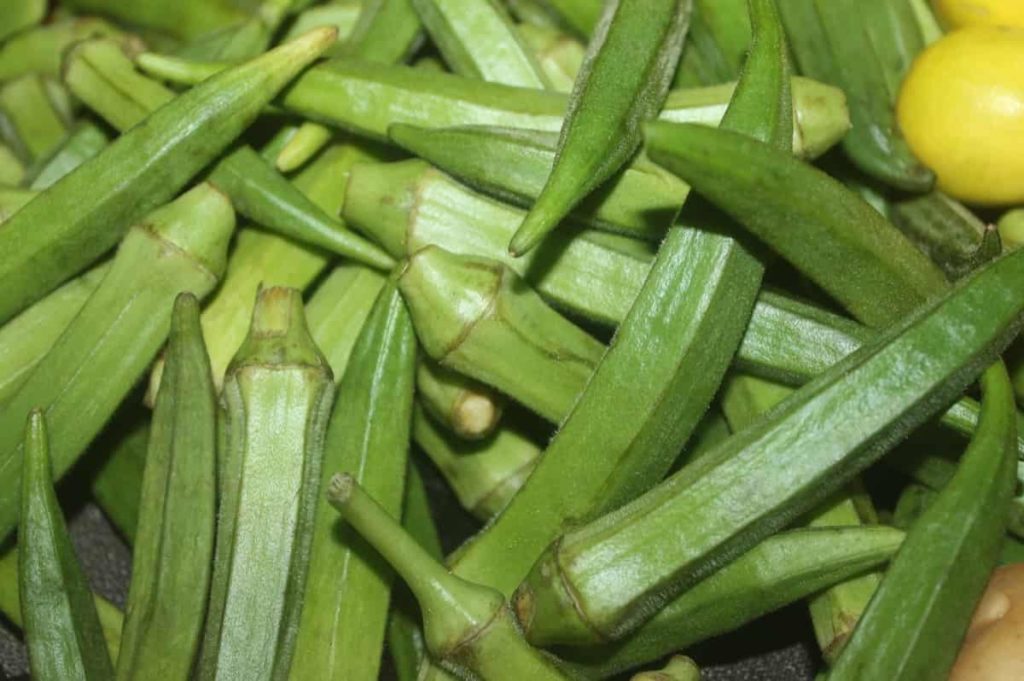
Step 15: Tips for harvesting Okra for more production
The critical step in any Okra farming is to harvest the pods correctly and at the right time. Harvesting methods vary according to the type of market. Around mid-summer, you can harvest long varieties to encourage further growth, and you can also choose to plant fresh crops at this time for late harvesting. You want to harvest your Okra when it is about three inches long, which is the best size for most farmers before they start to become wood.
If they are too tough and stringy at that length, you can start cutting them two inches. Okra plants should be inspected regularly and harvested when the fruits are at the size recommended for the market. Start pruning a few days after the end of flowering. The seed pods should be soft and two to three inches long. Pick pods at least every other day, as they soon become softer and harder as they age. Remove old seed pods, so they do not stop the growth of new pods.
- Economical Aquaculture: A Guide to Low-Budget Fish Farming
- 15 Common Planting Errors That Can Doom Your Fruit Trees
- How to Make Houseplants Bushy: Effective Tips and Ideas
- Innovative Strategies for Boosting Coconut Pollination and Yield
- Pollination Strategies for Maximum Pumpkin Yield
- The Complete Guide to Chicken Fattening: Strategies for Maximum Growth
- Natural Solutions for Tulip Problems: 100% Effective Remedies for Leaf and Bulb-Related Issues
- Revolutionizing Citrus Preservation: Towards a Healthier, Greener Future
- Natural Solutions for Peony Leaf and Flower Problems: 100% Effective Remedies
- Maximizing Profits with Avocado Contract Farming in India: A Comprehensive Guide
- Natural Solutions for Hydrangea Problems: 100% Effective Remedies for Leaf and Flowers
- The Ultimate Guide to Choosing the Perfect Foliage Friend: Bringing Life Indoors
- From Sunlight to Sustainability: 15 Ways to Use Solar Technology in Agriculture
- The Ultimate Guide to Dong Tao Chicken: Exploring from History to Raising
- The Eco-Friendly Makeover: How to Convert Your Unused Swimming Pool into a Fish Pond
- Mastering the Art of Delaware Chicken Farming: Essentials for Healthy Backyard Flocks
- 20 Best Homemade Fertilizers for Money Plant: DIY Recipes and Application Methods
- How to Craft a Comprehensive Free-Range Chicken Farming Business Plan
- Brighten Your Flock: Raising Easter Egger Chickens for Beauty and Bounty
- How to Optimize Your Poultry Egg Farm Business Plan with These Strategies
- Subsidy for Spirulina Cultivation: How Indian Government Schemes Encouraging Spirulina Farmers
- Ultimate Guide to Raising Dominique Chickens: Breeding, Feeding, Egg-Production, and Care
- Mastering the Art of Raising Jersey Giant Chickens: Care, Feeding, and More
- Ultimate Guide to Raising Legbar Chickens: Breeding, Farming Practices, Diet, Egg-Production
- How to Raise Welsummer Chickens: A Comprehensive Guide for Beginners
- How to Protect Indoor Plants in Winter: A Comprehensive Guide
- Ultimate Guide to Grow Bag Gardening: Tips, Tricks, and Planting Ideas for Urban Gardeners
- Guide to Lotus Cultivation: How to Propagate, Plant, Grow, Care, Cost, and Profit
- Agriculture Drone Subsidy Scheme: Government Kisan Subsidy, License, and How to Apply Online
- Ultimate Guide to Raising Araucana Chickens: Breed Profile, Farming Economics, Diet, and Care
- Bringing Hydroponics to Classroom: Importance, Benefits of Learning for School Students
- Ultimate Guide to Raising Polish Chickens: Breed Profile, Farming Economics, Diet, and Care
- Ultimate Guide to Raising Australorp Chickens: Profile, Farming Economics, Egg Production, Diet, and Care
- Silkie Chicken Farming: Raising Practices, Varieties, Egg Production, Diet, and Care
- Sussex Chicken Farming: Raising Practices, Varieties, Egg Production, Diet and Care
- Homemade Feed Formulations for Livestock: Discover Cost-effective Starter to Finisher Feed Recipes